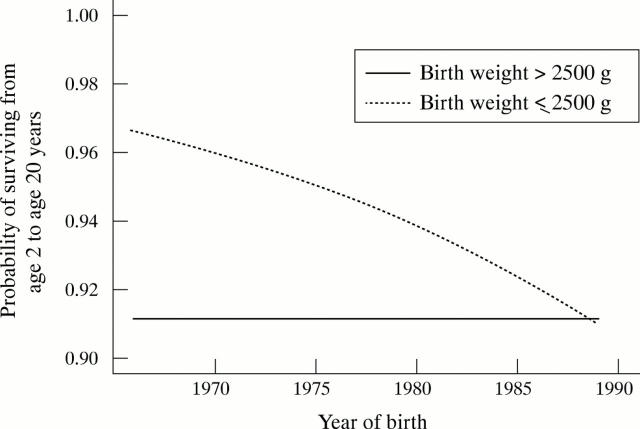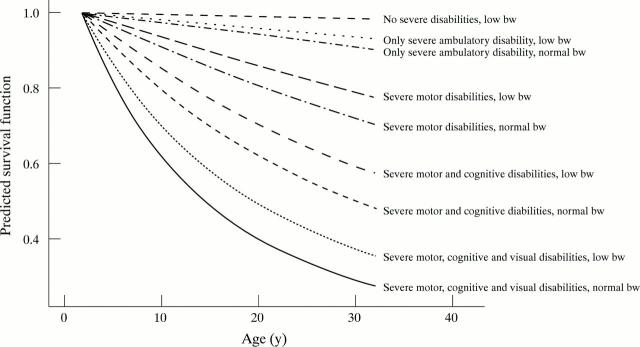Abstract
Background: Cerebral palsy presents with a range of severity of cognitive, motor, and sensory disabilities, which might affect survival.
Aims: To quantify the effects of motor, cognitive, and sensory disabilities, year of birth, birth weight, and gestational age on survival in cerebral palsy.
Methods: A cohort of children with cerebral palsy born between 1966 and 1989 to mothers resident in a defined geographical region was subdivided into early impairment (EICP: cerebral insult prenatally or within 28 days of birth) or late impairment (LICP: insult at least 28 days after birth). Deaths are notified by the National Health Service Central Register. Birth and disability details were obtained from clinical records. Survival analyses were carried out.
Results: Severe motor disability was associated with a 30 year survival of 42% and severe cognitive disability with a 30 year survival of 62%. Severe visual disability was associated with a 30 year survival of 38%, but the association of survival with hearing disability was weak. EICP had better survival than LICP but the difference was not significant after allowing for severity of functional disabilities. Normal birth weight infants (≥2500 g) showed no birth cohort effect, but the 10 year survival of low birth weight (<2500 g) infants declined from 97% for 1966 to 89% for 1989 births.
Conclusions: Survival in cerebral palsy varies according to the severity and number of functional disabilities and by birth weight. Among low birth weight children, survival declined steadily from 1966 to 1989 after allowing for disability. The disabilities reported do not capture all the factors affecting survival of preterm infants.
Full Text
The Full Text of this article is available as a PDF (115.6 KB).
Figure 1 .
Survival rates to age 20 from age 2 by year of birth.
Figure 2 .
Predicted survival from age 2 years. Normal bw, birth weight >2500 g; low bw, birth weight ≤2500 g.
Selected References
These references are in PubMed. This may not be the complete list of references from this article.
- Crichton J. U., Mackinnon M., White C. P. The life-expectancy of persons with cerebral palsy. Dev Med Child Neurol. 1995 Jul;37(7):567–576. doi: 10.1111/j.1469-8749.1995.tb12045.x. [DOI] [PubMed] [Google Scholar]
- Evans P. M., Evans S. J., Alberman E. Cerebral palsy: why we must plan for survival. Arch Dis Child. 1990 Dec;65(12):1329–1333. doi: 10.1136/adc.65.12.1329. [DOI] [PMC free article] [PubMed] [Google Scholar]
- Hutton J. L., Colver A. F., Mackie P. C. Effect of severity of disability on survival in north east England cerebral palsy cohort. Arch Dis Child. 2000 Dec;83(6):468–474. doi: 10.1136/adc.83.6.468. [DOI] [PMC free article] [PubMed] [Google Scholar]
- Hutton J. L., Cooke T., Pharoah P. O. Life expectancy in children with cerebral palsy. BMJ. 1994 Aug 13;309(6952):431–435. doi: 10.1136/bmj.309.6952.431. [DOI] [PMC free article] [PubMed] [Google Scholar]
- Mutch L., Alberman E., Hagberg B., Kodama K., Perat M. V. Cerebral palsy epidemiology: where are we now and where are we going? Dev Med Child Neurol. 1992 Jun;34(6):547–551. doi: 10.1111/j.1469-8749.1992.tb11479.x. [DOI] [PubMed] [Google Scholar]
- Nelson K. B., Ellenberg J. H. Children who "outgrew' cerebral palsy. Pediatrics. 1982 May;69(5):529–536. [PubMed] [Google Scholar]
- Pharoah P. O., Cooke T., Cooke R. W., Rosenbloom L. Birthweight specific trends in cerebral palsy. Arch Dis Child. 1990 Jun;65(6):602–606. doi: 10.1136/adc.65.6.602. [DOI] [PMC free article] [PubMed] [Google Scholar]
- Pharoah P. O., Cooke T., Rosenbloom I., Cooke R. W. Trends in birth prevalence of cerebral palsy. Arch Dis Child. 1987 Apr;62(4):379–384. doi: 10.1136/adc.62.4.379. [DOI] [PMC free article] [PubMed] [Google Scholar]
- Pharoah P. O., Platt M. J., Cooke T. The changing epidemiology of cerebral palsy. Arch Dis Child Fetal Neonatal Ed. 1996 Nov;75(3):F169–F173. doi: 10.1136/fn.75.3.f169. [DOI] [PMC free article] [PubMed] [Google Scholar]
- Strauss D. J., Shavelle R. M., Anderson T. W. Life expectancy of children with cerebral palsy. Pediatr Neurol. 1998 Feb;18(2):143–149. doi: 10.1016/s0887-8994(97)00172-0. [DOI] [PubMed] [Google Scholar]
- Strauss D., Shavelle R. Life expectancy of adults with cerebral palsy. Dev Med Child Neurol. 1998 Jun;40(6):369–375. [PubMed] [Google Scholar]
- Williams K., Alberman E. Survival in cerebral palsy: the role of severity and diagnostic labels. Dev Med Child Neurol. 1998 Jun;40(6):376–379. [PubMed] [Google Scholar]




